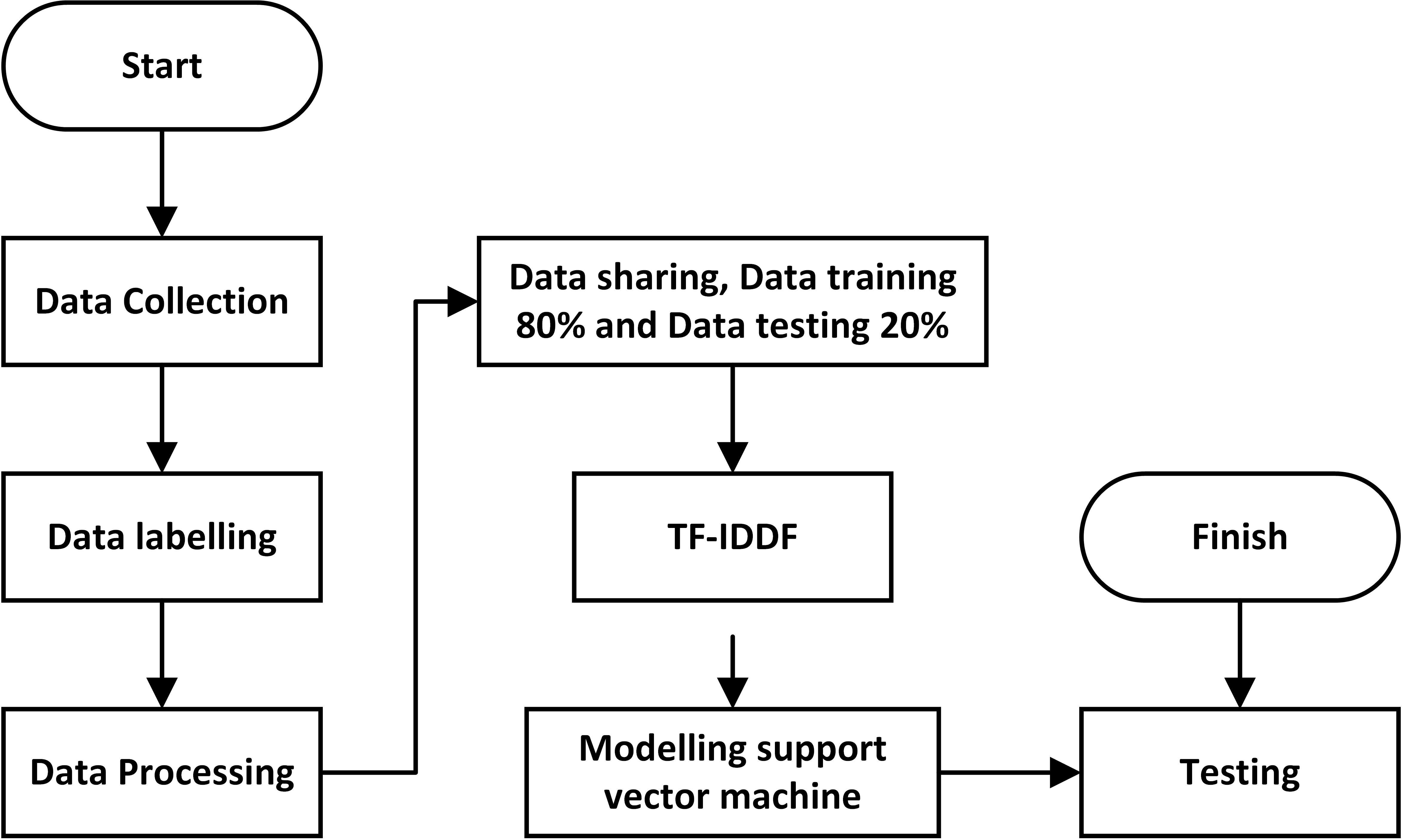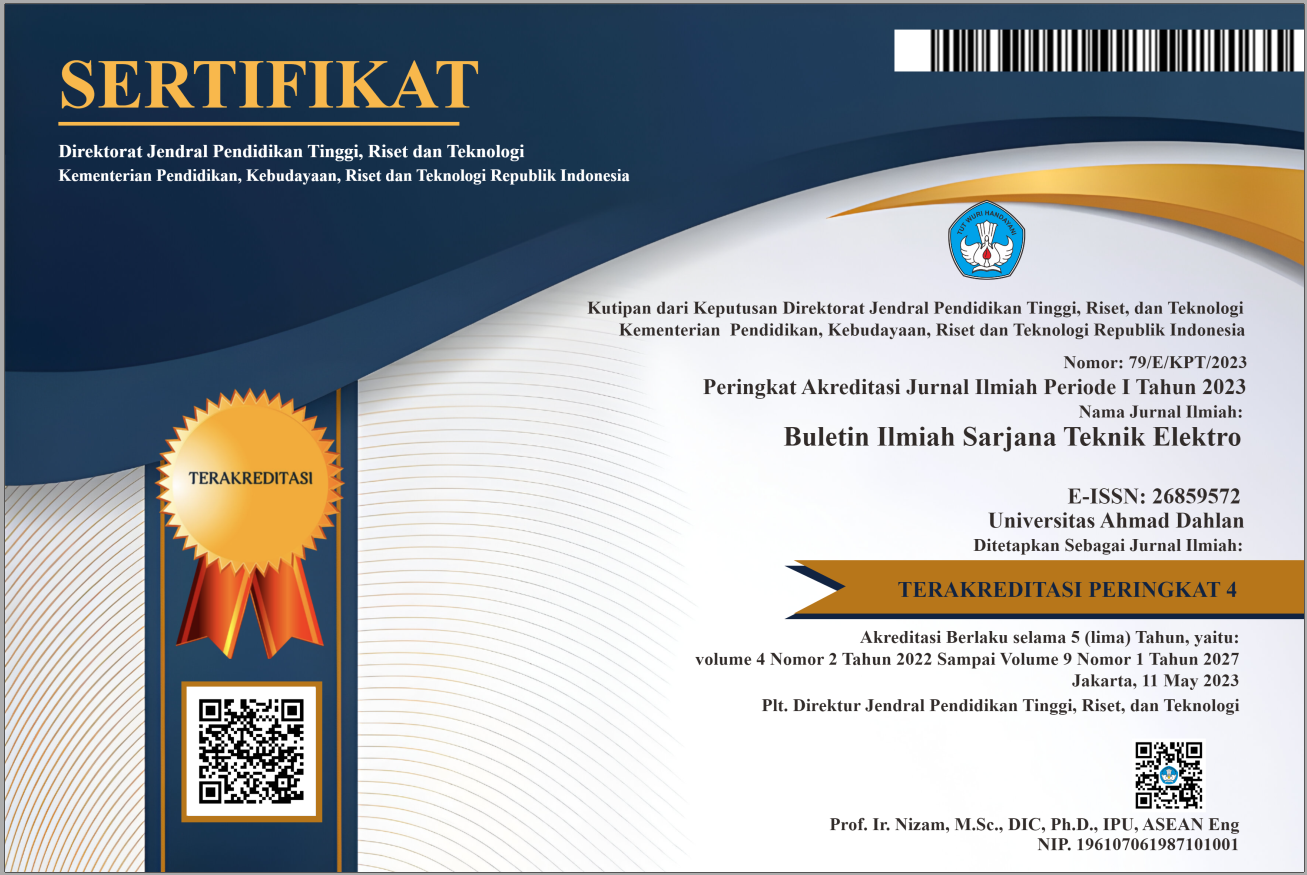Sentiment Analysis of Electronic System Provider (PSE) Method Using Support Vector Machine
DOI:
https://doi.org/10.12928/biste.v5i2.7416Keywords:
PSE, Support Vector Machine, Preprocessing, Facebook, StreamletAbstract
The study discusses the policy issued by the Indonesian Ministry of Communication and Information on Electronic System Providers (PSE), with a special emphasis on the impact of the policy that has triggered public reactions on social media platforms. Based on the regulations that have been made, it has an impact on the public who believe that the regulation is made to take away access freedom and data privacy on digital systems used by the public. Sentiment analysis can see public opinion on the policy issued by the Ministry of Communication and Information. The data used is taken from social media which is labeled "positive" and "negative". The research method used in sentiment analysis is the Support Vector Machine method. The contribution of this research is to determine the boundary line between the two classes in this research data. The result of the F1 score can be measured in the model, with a achieved value of 75%.
References
A. Syaifuddin et al., “Analisis Sentimen Pada Sosial Media Tentang Implementasi Kebijakan Pse Kominfo Menggunakan Algoritme Lexicon,” Pros. SEMASTEK 2022, vol. 1, no. 1, pp. 8–15, 2022, https://doi.org/10.36815/semastek.v1i1.2.
G. Kane, "The technology fallacy: people are the real key to digital transformation," Research-Technology Management, vol. 62, no. 6, pp. 44-49, 2019, https://doi.org/10.1080/08956308.2019.1661079.
Martin, T., Karopoulos, G., Hernández-Ramos, J. L., Kambourakis, G., & Nai Fovino, I. (2020). Demystifying COVID-19 digital contact tracing: A survey on frameworks and mobile apps. Wireless Communications and Mobile Computing, 2020, 1-29, 2020, https://doi.org/10.1155/2020/8851429.
A. Itten and N. Mouter, "When digital mass participation meets citizen deliberation: combining mini-and maxi-publics in climate policy-making," Sustainability, vol. 14, no. 8, p. 4656, 2022, https://doi.org/10.3390/su14084656.
I. Veza et al., "Electric vehicles in malaysia and indonesia: opportunities and challenges," Energies, vol. 15, no. 7, p. 2564, 2022, https://doi.org/10.3390/en15072564.
J. Kittur, "Measuring the Programming Self-Efficacy of Electrical and Electronics Engineering Students," in IEEE Transactions on Education, vol. 63, no. 3, pp. 216-223, 2020, https://doi.org/10.1109/TE.2020.2975342.
S. Pudaruth, S. Moheeputh, N. Permessur, and A. Chamroo, “Sentiment Analysis from Facebook Comments using Automatic Coding in NVivo 11,” ADCAIJ Adv. Distrib. Comput. Artif. Intell. J., vol. 7, no. 1, pp. 41–48, 2018, https://doi.org/10.14201/ADCAIJ2018714148.
N. Kewsuwun and S. Kajornkasirat, “A sentiment analysis model of agritech startup on Facebook comments using naive Bayes classifier,” Int. J. Electr. Comput. Eng., vol. 12, no. 3, pp. 2829–2838, 2022, https://doi.org/10.11591/ijece.v12i3.pp2829-2838.
M. Singh, A. K. Jakhar and S. Pandey, "Sentiment analysis on the impact of coronavirus in social life using the BERT model," Social Network Analysis and Mining, vol. 11, no. 1, p. 33, 2021, https://doi.org/10.1007/s13278-021-00737-z.
M. Ben Hajhmida and O. Oueslati, “Predicting mobile application breakout using sentiment analysis of Facebook posts,” J. Inf. Sci., vol. 47, no. 4, pp. 502–516, 2021, https://doi.org/10.1177/0165551520917099.
S. Chaudhari, R. Aparna, V. G. Tekkur, G. L. Pavan and S. R. Karki, "Ingredient/Recipe Algorithm using Web Mining and Web Scraping for Smart Chef," 2020 IEEE International Conference on Electronics, Computing and Communication Technologies (CONECCT), pp. 1-4, 2020, https://doi.org/10.1109/CONECCT50063.2020.9198450.
H. Samy, A. Helmy and N. Ramadan, "Aspect-based Sentiment Analysis of Mobile Apps Reviews using Class Association Rules and LDA," 2021 Tenth International Conference on Intelligent Computing and Information Systems (ICICIS), pp. 183-189, 2021, https://doi.org/10.1109/ICICIS52592.2021.9694242.
Y. Wang, Q. Chen, J. Shen, B. Hou, M. Ahmed, and Z. Li, “Aspect-level sentiment analysis based on gradual machine learning,” Knowledge-Based Syst., vol. 212, p. 106509, 2021, https://doi.org/10.1016/j.knosys.2020.106509.
A. Mustopa, Hermanto, Anna, E. B. Pratama, A. Hendini and D. Risdiansyah, "Analysis of User Reviews for the PeduliLindungi Application on Google Play Using the Support Vector Machine and Naive Bayes Algorithm Based on Particle Swarm Optimization," 2020 Fifth International Conference on Informatics and Computing (ICIC), pp. 1-7, 2020, https://doi.org/10.1109/ICIC50835.2020.9288655.
W. Bourequat and H. Mourad, “Sentiment Analysis Approach for Analyzing iPhone Release using Support Vector Machine,” Int. J. Adv. Data Inf. Syst., vol. 2, no. 1, pp. 36–44, 2021, https://doi.org/10.25008/ijadis.v2i1.1216.
J. Sangeetha and U. Kumaran, “A hybrid optimization algorithm using BiLSTM structure for sentiment analysis,” Meas. Sensors, vol. 25, no. 100619, p. 100619, 2023, https://doi.org/10.1016/j.measen.2022.100619.
M. K. Sohrabi and F. Hemmatian, "An efficient preprocessing method for supervised sentiment analysis by converting sentences to numerical vectors: a twitter case study," Multimedia tools and applications, 78(17), 24863-24882, 2019, https://doi.org/10.1007/s11042-019-7586-4.
A. W. Pradana and M. Hayaty, “The Effect of Stemming and Removal of Stopwords on the Accuracy of Sentiment Analysis on Indonesian-language Texts,” Kinet. Game Technol. Inf. Syst. Comput. Network, Comput. Electron. Control, vol. 4, no. 3, pp. 375–380, 2019, https://doi.org/10.22219/kinetik.v4i4.912.
L. Yang, Y. Li, J. Wang and R. S. Sherratt, "Sentiment Analysis for E-Commerce Product Reviews in Chinese Based on Sentiment Lexicon and Deep Learning," in IEEE Access, vol. 8, pp. 23522-23530, 2020, https://doi.org/10.1109/ACCESS.2020.2969854.
S. Ferilli, "Automatic multilingual stopwords identification from very small corpora," Electronics, vol. 10, no. 17, p. 2169, 2021, https://doi.org/10.3390/electronics10172169.
N. Saputra, K. Nurbagja, and T. Turiyan, “Sentiment Analysis of Presidential Candidates Anies Baswedan and Ganjar Pranowo Using Naïve Bayes Method,” J. Sisfotek Glob., vol. 12, no. 2, p. 114, 2022, https://doi.org/10.38101/sisfotek.v12i2.552.
M. Wongkar and A. Angdresey, "Sentiment Analysis Using Naive Bayes Algorithm Of The Data Crawler: Twitter," 2019 Fourth International Conference on Informatics and Computing (ICIC), pp. 1-5, 2019, https://doi.org/10.1109/ICIC47613.2019.8985884.
A. Septiana Sani and I. Budi, “Sentiment Analysis on Jurassic Park Development in the Komodo Conservation Area,” Int. Conf. Inf. Sci. Technol. Innov., vol. 1, no. 1, pp. 105–108, 2022, https://doi.org/10.35842/icostec.v1i1.18.
N. Kankanamge, T. Yigitcanlar, A. Goonetilleke M. Kamruzzaman, "Determining disaster severity through social media analysis: Testing the methodology with South East Queensland Flood tweets," International journal of disaster risk reduction, vol. 42, p. 101360, 2020, https://doi.org/10.1016/j.ijdrr.2019.101360.
R. Kosasih and A. Alberto, “Sentiment analysis of game product on shopee using the TF-IDF method and naive bayes classifier,” Ilk. J. Ilm., vol. 13, no. 2, pp. 101–109, 2021, https://doi.org/10.33096/ilkom.v13i2.721.101-109.
V. Ramanathan and T. Meyyappan, "Twitter Text Mining for Sentiment Analysis on People’s Feedback about Oman Tourism," 2019 4th MEC International Conference on Big Data and Smart City (ICBDSC), pp. 1-5, 2019, https://doi.org/10.1109/ICBDSC.2019.8645596.
N. S. Mohd Nafis and S. Awang, "An Enhanced Hybrid Feature Selection Technique Using Term Frequency-Inverse Document Frequency and Support Vector Machine-Recursive Feature Elimination for Sentiment Classification," in IEEE Access, vol. 9, pp. 52177-52192, 2021, https://doi.org/10.1109/ACCESS.2021.3069001.

Published
How to Cite
Issue
Section
License
Copyright (c) 2023 Turiyan Turiyan, Nurirwan Saputra, Ahmad Riyadi, Meilany Nonsi Tentua

This work is licensed under a Creative Commons Attribution-ShareAlike 4.0 International License.
Authors who publish with this journal agree to the following terms:
- Authors retain copyright and grant the journal right of first publication with the work simultaneously licensed under a Creative Commons Attribution License that allows others to share the work with an acknowledgment of the work's authorship and initial publication in this journal.
- Authors are able to enter into separate, additional contractual arrangements for the non-exclusive distribution of the journal's published version of the work (e.g., post it to an institutional repository or publish it in a book), with an acknowledgment of its initial publication in this journal.
- Authors are permitted and encouraged to post their work online (e.g., in institutional repositories or on their website) prior to and during the submission process, as it can lead to productive exchanges, as well as earlier and greater citation of published work (See The Effect of Open Access).
This journal is licensed under a Creative Commons Attribution-ShareAlike 4.0 International License.


